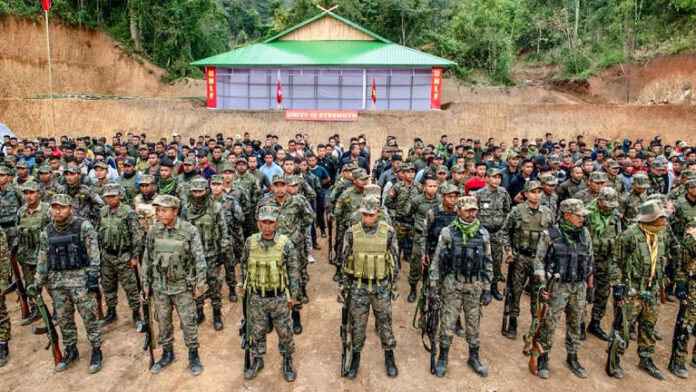The protracted ethnic conflict in Manipur has taken a disturbing turn as looted arms and ammunition from the state’s security establishments are reportedly being smuggled and sold beyond the valley, even crossing international borders. The development has heightened security concerns and poses a significant challenge to law enforcement agencies attempting to recover the stolen weaponry.
The Origin of the Arms Looting
The crisis began in May 2023, with escalating clashes between the Meitei and Kuki communities over ethnic and land disputes. Amid the unrest, mobs targeted police stations, armories, and security outposts, looting a staggering number of firearms, including sophisticated automatic rifles, pistols, and even grenades. The theft was not only widespread but alarmingly coordinated, resulting in thousands of weapons falling into civilian hands.
While the initial intent of the looting seemed to be self-defense in the context of ethnic violence, recent intelligence reports indicate that these arms have been entering illicit markets, fueling concerns of organized smuggling.
Spread Beyond the Valley
Security agencies have revealed that many of the looted weapons have moved beyond the conflict zone in Manipur. Some have reportedly made their way to insurgent groups operating in neighboring states such as Nagaland, Mizoram, and Assam. Even more concerning, there are indications that arms have crossed into Myanmar, a country already grappling with internal conflicts and a thriving black-market trade in weapons.
Manipur shares a porous border with Myanmar, facilitating the smuggling of arms and ammunition. The terrain, marked by dense forests and rugged hills, makes it challenging for security forces to monitor and control the flow of contraband effectively.
Impact on Regional Security
The proliferation of these looted weapons poses significant risks to regional security.
- Strengthening Insurgent Groups: The availability of advanced firearms is likely to embolden militant organizations, intensifying violence in India’s northeastern states and Myanmar.
- Threat to Civilians and Security Forces: Armed civilians and criminal networks equipped with military-grade weapons increase the risk of lawlessness and targeted attacks.
- Destabilizing Border Areas: The spread of arms beyond Manipur complicates border management and may strain India-Myanmar relations, especially regarding cross-border insurgencies.
Challenges in Recovery Efforts
Recovering the stolen arms has proven to be an uphill task for security forces. Some of the key challenges include:
- Resistance from Communities: Many civilians who possess the looted arms view them as a means of self-protection amid ongoing ethnic tensions. Efforts to reclaim weapons are often met with resistance, further complicating recovery missions.
- Porous Borders: The ease of moving contraband across the India-Myanmar border makes tracking and recovering smuggled arms exceedingly difficult.
- Inadequate Intelligence: Despite heightened surveillance, the lack of precise intelligence about the location of these weapons hampers recovery operations.
- Legal and Operational Constraints: The imposition of curfews and the ongoing unrest limit large-scale search and seizure operations.
According to officials, a fraction of the stolen arms—around 1,200 weapons—has been recovered so far, but this is only a small portion of the estimated thousands of arms looted during the unrest.
Steps Taken by Authorities
Recognizing the gravity of the situation, both the state and central governments have initiated measures to address the crisis.
- Intensified Recovery Drives: Security forces have launched targeted operations to locate and confiscate looted arms, focusing on high-risk zones.
- Enhanced Border Security: Efforts are underway to tighten monitoring along the India-Myanmar border, including deploying additional personnel and installing surveillance equipment.
- Appeals to Civilians: Authorities have appealed to citizens to voluntarily surrender looted weapons, promising immunity to those who cooperate. However, the response has been lukewarm.
- Collaboration with Myanmar: Diplomatic channels are being explored to curb cross-border smuggling and strengthen intelligence-sharing mechanisms.
The Way Forward
Experts argue that addressing the arms crisis in Manipur requires a comprehensive approach:
- Dialogue and Reconciliation: Reducing the ethnic tensions driving the conflict is essential to disarmament efforts.
- Technology Integration: Employing advanced surveillance tools like drones and satellite imaging can enhance border security and aid recovery operations.
- Community Engagement: Building trust between civilians and authorities can encourage voluntary surrender of weapons.
- Tackling Smuggling Networks: A crackdown on organized crime syndicates involved in arms smuggling is critical to stem the proliferation of looted weapons.
The looting and smuggling of arms in Manipur underscore the complex interplay between ethnic conflict, organized crime, and regional security challenges. As stolen weapons spread beyond the valley and across borders, the task of recovery becomes increasingly urgent yet daunting.
Restoring peace and stability in Manipur is not just a matter of law enforcement but a broader challenge that requires addressing the root causes of unrest, fostering cooperation between communities, and strengthening the region’s security apparatus. The resolution of this crisis will serve as a litmus test for India’s ability to manage internal conflicts with regional and international implications.




